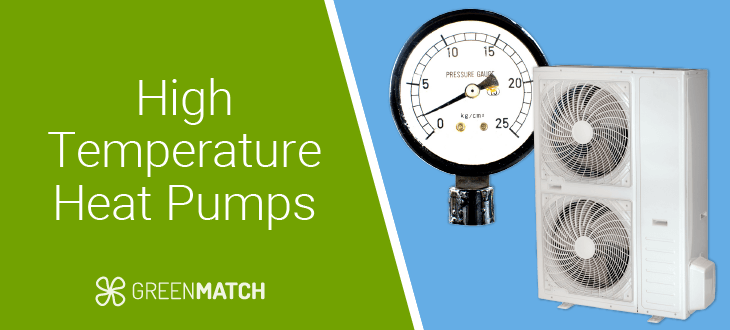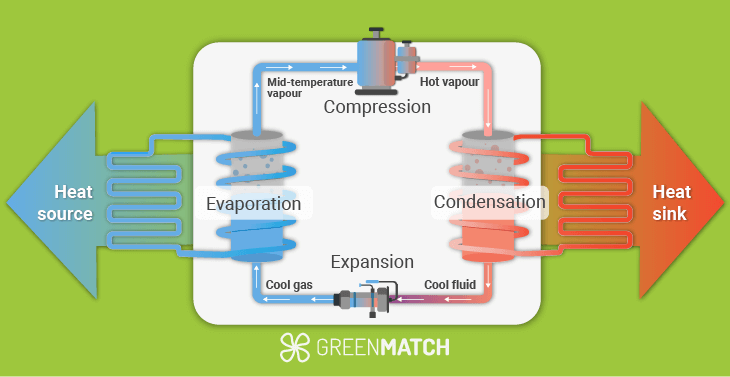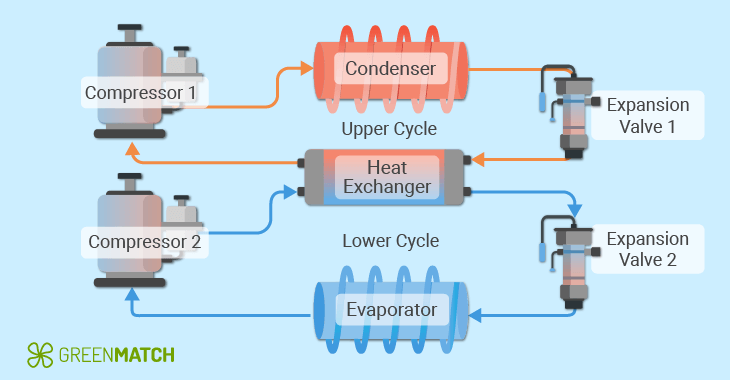Answer these simple questions and we will find you the BEST prices
Which type of solar quotes do you need?
It only takes 30 seconds
100% free with no obligation

Get up to 4 quotes by filling in only 1 quick form

Install a heat pump for less with the BUS grant

We’ve helped over 500,000 homeowners reduce their carbon footprint
- GreenMatch
- Heat Pumps
- High Temperature Heat Pumps
High Temperature Heat Pump: Costs & Benefits (October 2025)


- A high temperature heat pump supplies heating to your home between 60°C to 80°C.
- With a high temperature heat pump, there is less need to insulate your home or replace your radiators.
- A high temperature heat pump costs between £11,000 to £42,500.
A high temperature heat pump is a low-carbon heating system that can reach between 60°C to 80°C, heating your home to levels comparable to a conventional gas boiler.
Compared to a normal heat pump, a high temperature heat pump will take less time to heat your home. They can also reach higher temperatures and require less extensive insulation.
Typically, regular heat pumps can reach between 44°C to 55°C and rely on insulation or large radiators to operate effectively.
In this guide, we'll tell you all about how these high temperature heat pumps work, what costs you can expect along the way, and we’ll take a closer look at the pros and cons compared to other heating systems.
We can also show you the best way you can save on new high temperature heat pump installation. Through GreenMatch, you can find the best deal possible by comparing up to 4 of the top-rated installers from our network of professionals.
Simply fill out our 30-second form, and then we’ll provide you with up to 4 quotes, all of them free and tailored to your needs. Save yourself hours of time and hassle of finding installers alone, and get your exclusive quotes from GreenMatch.
To get started, click the button below.
- Quotes from local engineers
- Payment by finance available
- Save £7,500 with BUS grant
It only takes 30 seconds



- What is a high temperature heat pump and how does it work?
- High temperature heat pump costs
- High temperature heat pumps: Pros & cons
- How efficient are high temperature heat pumps in the UK?
- Is a high temperature heat pump suitable for your home?
- Is it worth getting a high temperature heat pump?
- Frequently asked questions
What is a high temperature heat pump and how does it work?
High temperature heat pumps work in the same way as a normal heat pump, in that they run on electricity and produce 3-4 times the heat energy with every kilowatt of electricity it uses. These systems also generate heat from a renewable source, usually from the outside air, beneath the ground, or a water source. The heat is then transferred to your home via a refrigerant cycle.
High temperature heat pumps, however, operate at higher temperatures, producing heat levels of 60°C or more. To increase the heat levels produced from the cycle, high temperature heat pumps use advanced components such as compressors and heat exchangers. Select refrigerants also work best for high temperature heat pumps, since they can compress and evaporate at high temperatures.
High temperature heat pumps in the UK tend to use either R290 (propane) or R32 (hydrofluorocarbon).
| High temperature heat pump refrigerants | ||||
|---|---|---|---|---|
| Refrigerant | Code | Global warming potential | Flammable | Toxic |
| Propane | R290 | 4 | Yes | Yes |
| Hydrofluorocarbon | R32 | 675 | Yes | No |
R290 is environmentally friendly and energy efficient, as a pure gas that doesn't emit greenhouse gases into the atmosphere.
R32 is also highly efficient and has less global warming potential when compared to other refrigerants. One advantage it does have over R290 is that it is non-toxic and less flammable.
Both these refrigerants allow for advanced weather compensation, meaning your heating system reacts to the outside weather conditions by adjusting the heat supply to your home.

1. Evaporation: Heat is absorbed from the source and converted into a low-pressure, low-temperature gas.
2. Compression: The gas is compressed to increase its pressure and temperature.
3. Condensation: The gas is converted back to a fluid in the heat sink or cold plate to conserve heat energy.
4. Heat sink: The fluid then travels through your central heating or underfloor heating system via the heat sink. Depending on the type of heat pump, it can also provide domestic hot water.
5. Expansion: The fluid returns to the expansion valves where it evaporates, reducing the temperature and pressure, and restarting the cycle.
'Cascade' high temperature heat pumps
Cascade vapour-compression heat pumps are becoming more popular since they allow for a continuous heat transfer from one unit to another, making them run more efficiently.
Cascade systems operate on a two-stage principle to achieve a higher temperature lift. It does this through evaporation and condensation at low pressure, while maintaining its high temperature output.
In this system, two cycles, one low temperature and one high temperature work at the same time using different refrigerants.

The first heat pump lifts the temperature and then transfers to the second stage heat pump. In this low-temperature cycle, the refrigerant evaporates at a low temperature.
It is then condensed in the heat exchanger at a relatively low pressure and temperature, which facilitates the transfer of heat to the evaporator. As a result of this heat transfer, the second refrigerant absorbs the heat and lifts it further.
The two cycles are connected by a heat exchanger, which acts as both the condenser and evaporator between the two stages.
Difference between normal and high temperature heat pumps
Compared to regular heat pumps, high temperature heat pumps operate at higher temperatures, whether it's an air, ground, hybrid heat pump system or water source heat pump.
Regular heat pumps can typically reach temperatures of 45°C to 55°C, although the latest models tend to reach up to 65°C. Since they can reach similar levels of heating output but require less electricity to run, modern heat pumps are increasingly competitive with high temperature heat pumps.
High temperature systems are more expensive up front, considering the specialist components and refrigerants required to carry out advanced compression and evaporation. The high temperature cycle also requires some more electricity to run compared to a regular heat pump.
High temperature heat pumps may still be preferable, however, since you are less likely to have to retrofit your home before having one installed. That's because they can provide adequate amounts of heat using standard-sized radiators.
Regular heat pumps can not produce enough heat so you will require adequate insulation and larger radiators. Insulation measures vary from home to home.
Altogether you might end up spending an additional £9,000, or more, on top of your new heating system. However, we do recommend that your home is adequately insulated regardless of the heat system you choose.
High temperature heat pump costs
High temperature heat pumps tend to cost between £11,000 to £42,500. This will vary according to the type of heat pump you install, and its size. Air source heat pump installations are considerably less extensive than ground source, therefore for their upfront installation costs come to significantly less compared to the ground source heat pump cost.
Below we've estimated the potential supply and installation costs of air to water heat pumps compared to horizontal and vertical ground source heat pumps.
| High temperature heat pump costs | |||
|---|---|---|---|
| Type of heat pump | 8kW | 12kW | 16kW |
| Air to water | £11,000 | £14,500 | £17,500 |
| Horizontal ground source | £20,250 | £28,000 | £38,750 |
| Vertical ground source | £29,000 | £39,400 | £42,500 |
Compared to the supply and installation of regular heat pump systems, high temperature heat pumps tend to cost at least 25% more. Typically, an air source heat pump in the UK costs £4,000 - £15,000, and horizontal and vertical ground source heat pumps cost between £16,200 - £34,050.
For homeowners in England and Wales, you may be eligible for a heat pump grant of £7,500 towards your new high temperature heat pump installation, through the Boiler Upgrade Scheme. Check out if you're eligible by visiting GOV.UK.
Remember, these prices are only estimates. For the most accurate prices, tailored to your situation, then use our free quotes service.
We can help you save hours of searching for the right installer by matching you with up to 4 professional options from within our wide network of vetted experts. You can then select the best quote knowing that you're choosing from the most suitable installers for the job.
To get your free, local, no-obligation quotes, click the button below.
- Quotes from local engineers
- Payment by finance available
- Save £7,500 with BUS grant
It only takes 30 seconds



High temperature heat pumps: Pros & cons
- Less need to install new radiators or insulation
- Capable of producing heat at the same temperature as a conventional gas boiler
- Comparable efficiency to other heat pumps
- Higher efficiency compared to boilers
- Environmentally friendlier than boilers
- Generally pricier than regular heat pumps
- Operating costs are typically higher than a gas boiler
- Longer heat-up times with higher temperature output
- Increased electricity consumption
How efficient are high temperature heat pumps in the UK?
When considering the efficiency of high-temperature heat pumps in the UK, a key metric is the Coefficient of Performance (COP). This measure estimates a heat pump's efficiency over a year.
New heat pumps tend to come with a COP ranging from 2 to 4, depending on the type of heat pump you install. Air to air heat pumps tend to have a COP of 2 - 2.5. The best air source heat pumps come with a COP of 3 - 3.5, whereas ground source heat pumps can reach a COP of 4, and even up to 4.5.
This means for every unit of electricity consumed, the heat pump generates 2 to 4 units of energy.
It's important to note that efficiency fluctuates throughout the seasons. Winter demands higher temperatures for home heating which tends to lower the heat pump's efficiency. During the milder spring and autumn months, the efficiency is more effective, as the heat pump can operate at lower temperatures.
It's important to note that manufacturers tend to offer a COP based on lower output temperatures when the heat pump is operating at its highest efficiency.
To optimise efficiency, high temperatures should be reserved when necessary to minimise the workload on the heat pump.
Is a high temperature heat pump suitable for your home?
While most homes can benefit from a high temperature heat pump, some homes are more suited than others.
You should consider installing a high temperature heat pump if:
- Your home is especially difficult to insulate.
- Your home is a Listed Building or in a Conservation Area.
- Your home isn't connected to the gas grid.
Is it worth getting a high temperature heat pump?
There are several compelling reasons to consider a new high temperature heat pump. Firstly, high temperature heat pumps outperform traditional gas boilers in terms of efficiency, at least 2-4 times as much, depending on the efficiency of your existing boiler and the COP of your heat pump.
Compared to gas boilers, these heat pumps are more environmentally friendly since they rely on a renewable energy source rather than burning fossil fuels directly.
Depending on the COP and current fuel prices under the energy price cap, high temperature heat pumps can potentially be more affordable to run than gas boilers. What's more, they are highly likely to offer more cost savings compared to electric heating systems.
However, the efficiency and running costs of a high temperature heat pump do depend on the temperature output. If you often require higher temperatures, it's important to consider the potential impact on your electricity bill. Relying extensively on higher temperatures may lead to a considerable increase in energy consumption and costs.
One way you're sure to make savings, however, is by choosing an installer that offers a nice deal. Searching for the perfect installer can result in countless hours of helpless research. With GreenMatch, you can skip all this by filling in our 30-second form.
We'll make sure you find the best option by connecting you with 4 top quality air source heat pump quotes, all of them based in your local area. They can help you with all your questions and concerns - from air source heat pump noise levels to the best heat pump size to your home - and offer you tailored quotes for their services.
Ready to compare some free, no-obligation quotes? Click the button below to get started!
- Quotes from local engineers
- Payment by finance available
- Save £7,500 with BUS grant
It only takes 30 seconds



Frequently asked questions
High temperature domestic heat pumps can provide heating up to 80°C, the same as traditional gas boilers. Regular heat pumps tend to reach up to 55°C.
High temperature heat pumps cost the same amount to run as regular heat pumps, as long as the temperature output remains towards the lower end. If you require higher temperatures, then your heat pump will become more expensive to run.
The main difference between high temperature heat pumps and regular heat pumps is the temperature output they can reach. High temperature heat pumps can reach temperatures between 60 – 80°C, whereas regular heat pumps tend to operate between 45 – 55°C.

Ciaran is a content writer at GreenMatch. Whether writing about sustainable aviation fuel or heat pumps, Ciaran has passion for informing readers about pivotal technologies that are reshaping our world.
We strive to connect our customers with the right product and supplier. Would you like to be part of GreenMatch?

- High Temperature Heat Pumps: How They Work, Costs & Benefits
- What is a high temperature heat pump and how does it work?
- High temperature heat pump costs
- High temperature heat pumps: Pros & cons
- How efficient are high temperature heat pumps in the UK?
- Is a high temperature heat pump suitable for your home?
- Is it worth getting a high temperature heat pump?
- Frequently asked questions
Stay up to date with energy saving tips and grant alerts
Receive offers, marketing and promotions via email from Leads.io about GreenMatch and our brands/partners to help you save.
Thank you for subscribing to our newsletter!
Your email has been successfully added to our list. We look forward to sharing our latest updates with you soon!



